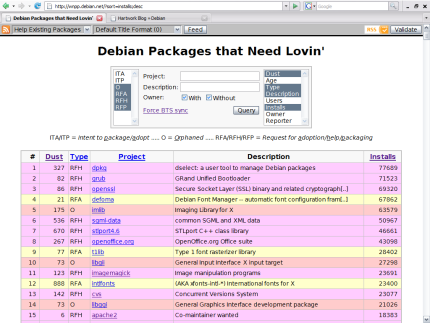Introducing doxygen2qthelp
Just a quick note for people not subscribed to
Trolltech Labs:
A few hours ago I blogged about a new
tool called doxygen2qthelp helping Doxygen out without creating .qch files.
The post can be found here:
Introducing doxygen2qthelp: Create .qch files from Doxygen. Finally.
Infinity Bread

uriparser 0.7.1 released
Ogg DirectShow filters need new maintainer
Let me just cite Silvia's mail to the vorbis-devel mailing list here:
Sorry for the heavy cross-posting, but this is important.
Zen Kavanaugh, who used to develop the Ogg DirectShow filters has crossed over to commercial life and is now working at Microsoft where he is not allowed to continue working on Open Source media technology. It’s congratulations to Zen – but the DirectShow filters are now searching for a new maintainer. If you develop in Windows and are able to compile, test and package the DirectShow filters that are available from http://www.illiminable.com/ogg/ please consider taking them on.
At this point in time, there is not much actual development required – just the occasional application of a patch, compilation, packaging and then publication.
This is really important, so if you can help you should really consider stepping forward.
Go for it!
Cheers, Silvia.
2 minute summary on "Unicode explained"
I skip-read through Unicode explained (Jukka K. Korpela, O'Reilly, First edition June 2006) during the last few weeks. While I found the book overall quite boring I still learned a few things, among them most importantly three things I'd like to share with you:
- Unicode does not contain a code point for every known character
- The Unicode space is 21 bits large
- Therefore UTF-8, UTF-16 and UTF-32 can all express the full character set of Unicode
uriparser 0.7.0 released
This release is a feature release, mainly adding dissection and composition of query strings. Previously query strings were block of text and nothing more. Now you can use them as key/value pairs, as application/x-www-form-urlencoded data. Please see the API documentation and change log for details. This release is both source- and binary-compatible.
Integrating Qt's Meta object compiler (moc) with GNU Automake
Smoothly integrating Moc into a GNU autotools project is not trivial. What I present here is just one way, rather than "the way". Actually just a few bytes to get you started. Let's go.
File Makefile.am:
include ${top_srcdir}/moc.mk bin_PROGRAMS = \ automoc $(automoc_OBJECTS) : \ moc_qobject_class_a.cpp \ moc_qobject_class_b.cpp automoc_SOURCES = \ qobject_class_a.h \ qobject_class_b.h \ \ qobject_class_a.cpp \ qobject_class_b.cpp
Since the object files of our example program automoc all depend on the moc
files, make will first generate all the mocs and then start compiling.
File moc.mk:
moc_%.cpp : %.h $(MOC) -i -o "$@" "$<" clean-moc-extra: rm -vf moc_*.cpp clean-am: clean-moc-extra
Keep in mind we are embedding plain GNU Make rules here so true tab characters are needed before the commands. This can only work as is with the original C++ source files including the related moc source files:
File qobject_class_a.cpp:
.. #include "qobject_class_a.h" .. .. #include "moc_qobject_class_a.cpp"
To see this solution at work have a look at the Relacs Subversion repository. As a last note don't forget to make sure that you are calling the right moc, either that of Qt3 or Qt4. Good luck!
Debian Packages that Need Lovin'
When I first announced the Debian Packages that Need Lovin' page in January it was in early beta state. In the meantime it became stable and usable so I feel like catching up on advertising it with a picture finally.
I wonder if Steve Dibb knows that I chose the name after his Gentoo Packages that Need Lovin' project.
The Autotools file jungle
As a fall-out of a GNU Autotools conversion I am currently working on I made an overview graph of the files and tools involved with an GNU Autotools-bases project. The filled, grey ellipses are tools you need to have installed. All other ellipses represent files specific to the related Autotools project.

The above image is licensed under Creative Commons Attribution-Share Alike 3.0 and can be re-generated by Neato 2.16 of GraphViz when fed with this source file.
Thunderbird and Spam with no body
This is what Thunderbird has to say about it:

